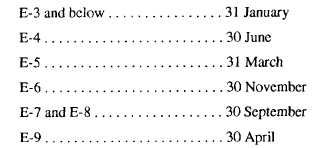Navy training. The PQS lists the knowledge and skills
required to qualify for a specific watch station, maintain
a specific equipment or system, or perform as a team
member within the assigned unit. The PQS is in the
format of a qualification guide. It asks the questions a
trainee must answer to verify his readiness to perform a
given task and provides a record of his progress and final
certification. The PQS approach to training is based on
individual learning. The learner has the complete
written program in his hands. The operational
supervisor provides assistance and maintains quality
control over the learning process. PQS may be signed
off only by personnel who are qualified and have
been designated to certify completion of each PQS.
When a person is certified in a PQS, he may also
have that standard signed off in PARs if it is duplicated
there.
Leadership Training
Every officer, petty officer, and potential petty
officer on the ship should have leadership training. They
need it to learn how to get the job done through people.
The techniques of management, administration, and
supervision that underlie leadership are always
changing as the working world learns better ways.
Therefore, leadership training is always needed. Most
ships can provide training aids and materials on
leadership. Most ships have graduates of the Navy
Leadership Development (NLD) program and they can
offer lectures on leadership for those who have not had
training.
PERFORMANCE EVALUATIONS
Refer to the Naval Military Personnel Command
lnstruction, NAVMILCOMINST 1616.1, for more
information on performance evaluations.
The Navy’s evaluation system allows the
commanding officer to exert a positive influence upon
the selection of those who will be advanced. He does so
by recommending only those who will serve the Navy
best. He can do that only if supervisors give him realistic
performance evaluations based on demonstrated
performance. If all candidates are rated too highly, the
commanding officer cannot help those who most
deserve it. Recommend advancement only for those
who (1) have met all of the qualifications for
advancement, (2) have performed well in their present
rates, and (3) probably will perform well in the higher
rate.
Since all Navy enlistees must meet minimum
standards to enter the Navy, we can assume that each
ship probably has an average crew. That means, for
evaluations, there should be about as many above
average as below. This is the “average crew” concept
and it should be used to evaluate any group of candidates
who are trying to advance to the same rate.
Be completely frank in enlisted evaluation reports.
Always report outstanding performance and always
report individual shortcomings. Supervisors need to
know both when they select personnel for duty
assignments.
Prepare and
submit
regular
evaluation
reports according to the following schedule: For
E-4 and below, use NAVPERS 1616/24, (single
sheet); for E5 and above, use NAVPERS 1616/24 (OCR
set).
Servicewide examinations for advancement in
rating are conducted each year in March and September
for paygrades E-4 through E-6 and in January for
paygrade E-7. These examinations are prepared by
senior petty officers in each rating at the Naval
Education and Training Program Management Support
Activity, Pensacola, Florida. Each examination is based
on the professional requirements of the rate.
TRAINING RECORDS
The true
measure of an effective training
program is performance, and any records should be
created to reach that goal in the simplest way possible.
The only justification for a record of training is to show
how much training has been done and how much
remains to be done. Therefore, keep records to an
absolute minimum consistent with needs and the
requirements of higher authority. When possible, use the
same forms to schedule training and to record completed
training.
Type commanders
and commanding officers
will prescribe some records. The schedules and
records discussed in this section are an example of a
system to help plan, administer, and control a
3-9

